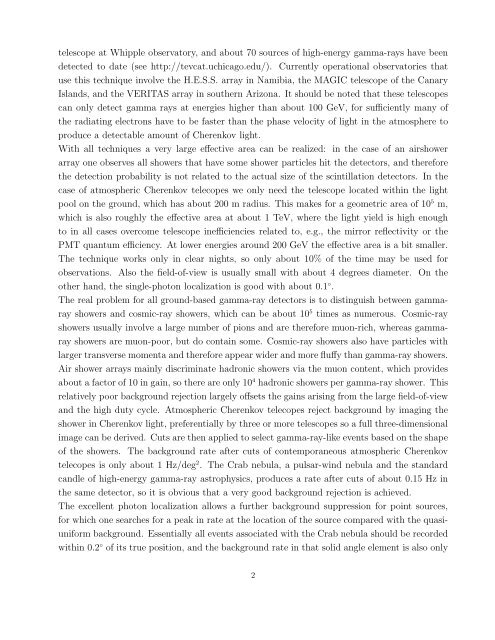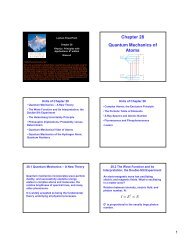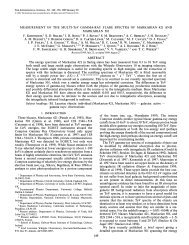Lecture notes - Desy
Lecture notes - Desy
Lecture notes - Desy
You also want an ePaper? Increase the reach of your titles
YUMPU automatically turns print PDFs into web optimized ePapers that Google loves.
telescope at Whipple observatory, and about 70 sources of high-energy gamma-rays have been<br />
detected to date (see http://tevcat.uchicago.edu/). Currently operational observatories that<br />
use this technique involve the H.E.S.S. array in Namibia, the MAGIC telescope of the Canary<br />
Islands, and the VERITAS array in southern Arizona. It should be noted that these telescopes<br />
can only detect gamma rays at energies higher than about 100 GeV, for sufficiently many of<br />
the radiating electrons have to be faster than the phase velocity of light in the atmosphere to<br />
produce a detectable amount of Cherenkov light.<br />
With all techniques a very large effective area can be realized: in the case of an airshower<br />
array one observes all showers that have some shower particles hit the detectors, and therefore<br />
the detection probability is not related to the actual size of the scintillation detectors. In the<br />
case of atmospheric Cherenkov telecopes we only need the telescope located within the light<br />
pool on the ground, which has about 200 m radius. This makes for a geometric area of 10 5 m,<br />
which is also roughly the effective area at about 1 TeV, where the light yield is high enough<br />
to in all cases overcome telescope inefficiencies related to, e.g., the mirror reflectivity or the<br />
PMT quantum efficiency. At lower energies around 200 GeV the effective area is a bit smaller.<br />
The technique works only in clear nights, so only about 10% of the time may be used for<br />
observations. Also the field-of-view is usually small with about 4 degrees diameter. On the<br />
other hand, the single-photon localization is good with about 0.1 ◦ .<br />
The real problem for all ground-based gamma-ray detectors is to distinguish between gammaray<br />
showers and cosmic-ray showers, which can be about 10 5 times as numerous. Cosmic-ray<br />
showers usually involve a large number of pions and are therefore muon-rich, whereas gammaray<br />
showers are muon-poor, but do contain some. Cosmic-ray showers also have particles with<br />
larger transverse momenta and therefore appear wider and more fluffy than gamma-ray showers.<br />
Air shower arrays mainly discriminate hadronic showers via the muon content, which provides<br />
about a factor of 10 in gain, so there are only 10 4 hadronic showers per gamma-ray shower. This<br />
relatively poor background rejection largely offsets the gains arising from the large field-of-view<br />
and the high duty cycle. Atmospheric Cherenkov telecopes reject background by imaging the<br />
shower in Cherenkov light, preferentially by three or more telescopes so a full three-dimensional<br />
image can be derived. Cuts are then applied to select gamma-ray-like events based on the shape<br />
of the showers. The background rate after cuts of contemporaneous atmospheric Cherenkov<br />
telecopes is only about 1 Hz/deg 2 . The Crab nebula, a pulsar-wind nebula and the standard<br />
candle of high-energy gamma-ray astrophysics, produces a rate after cuts of about 0.15 Hz in<br />
the same detector, so it is obvious that a very good background rejection is achieved.<br />
The excellent photon localization allows a further background suppression for point sources,<br />
for which one searches for a peak in rate at the location of the source compared with the quasiuniform<br />
background. Essentially all events associated with the Crab nebula should be recorded<br />
within 0.2 ◦ of its true position, and the background rate in that solid angle element is also only<br />
2







